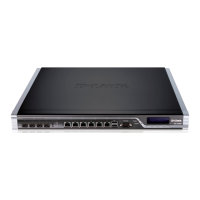Example 4.10. Add an OSPF Area
Now add an OSPF Area object to the OSPF Router Process object as_0 on firewall A. This area will be the OSPF
backbone area and will therefore have the ID 0.0.0.0. Assume the name for the area object will be area_0.
Command-Line Interface
First, change the CLI context to be the OSPFProcess object created above:
gw-world:/> cc OSPFProcess as_0
Now, add the area:
gw-world:/as_0> add OSPFArea area_0 AreaID=0.0.0.0
This new OSPFArea object can be displayed with the command:
gw-world:/as_0> show
OSPFArea/
Name Area ID Comments
---- ------- --------
! area_1 0.0.0.0 <empty>
Web Interface
1. Go to: Routing > OSPF
2. Select the routing process as_0
3. Select Add > OSPF Area
4. For the area properties:
• Enter the area name, in this case area_0
• Specify the Area ID as 0.0.0.0
5. Click OK
Now, repeat this for firewall B, using the same OSPF Area object name of area_0.
Example 4.11. Add OSPF Interface Objects
For firewall A, add OSPF Interface objects for each physical interface that is to be part of the OSPF area called
area_0.
Command-Line Interface
Assume the context is still the OSPFProcess called as_0 from the last example. Now, change the context to be
the OSPFArea that was created previously:
gw-world:/as_0> cc area_0
Next, add the OSPFInterface object:
gw-world:/as_0/area_0> add OSPFInterface If1 Passive=Yes
Enabling the Passive option means that this interface is not connected to another OSPF router. Finally, return to
the default CLI context:
gw-world:/as_0/area_0> cc
gw-world:/>
4.5.6. An OSPF Example Chapter 4. Routing
221

